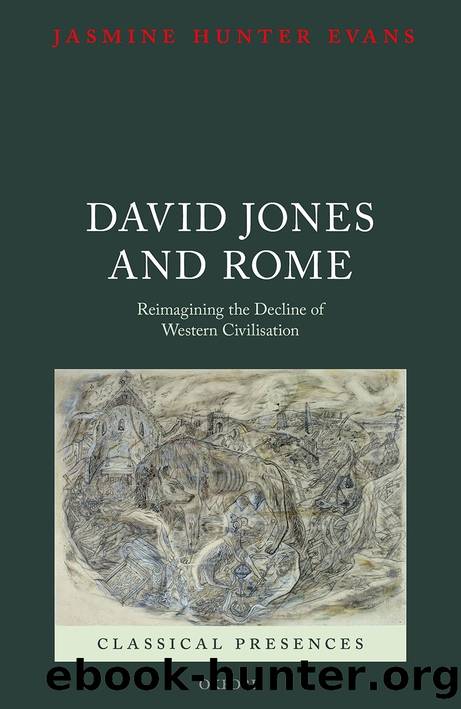David Jones and Rome by Jasmine Hunter Evans;

Author:Jasmine Hunter Evans; [Hunter Evans, Jasmine]
Language: eng
Format: epub
ISBN: 9780192638595
Publisher: OUP Premium
Published: 2022-01-04T00:00:00+00:00
Yet there is more depth to Jonesâs âassociationsâ in this passage. In taking the quotation not from Homerâs Greek Iliad but from Aeneasâs vision within Virgilâs Latin Aeneid, Jones also reminds us of the central position of Aeneas and Rome in the Western tradition. In Aeneasâs dream which he re-tells to Dido, the ghostly Hector passes onto him not only the Penates (household gods), which represent the culture of the Trojans, but also his position as leader, as he commands Aeneas to lead the exiled Trojans to found a new city which will become Rome, a duty which will involve Aeneasâs own sacrifice of his relationship with Dido (II, 293â295). Jones thus represents the continuity between the ancient Greek, Roman, and Christian traditions through the figures and sacrifice of their heroes, Hector, Aeneas, and Christ, and through the passing on of spiritual and cultural inheritance both in their narratives and across the wider myth these seminal texts preserve about the Western past. Within Rome, founded by Aeneas on the Trojan heritage bequeathed by Hector, Christianity was born, and through the Christian tradition the modern West received both a classical and Christian inheritance. In this way, Rome sits at the centre of Jonesâs vision of Western culture but it also has a special relationship with Britain and Wales. Whenever Jones contemplates Troy, his connective mind draws him to the myth of Britainâs Trojan heritage in which, through Hector, Aeneas, and the Trojan âBruteâ, who becomes the first king of Britain, London was âTroy Novantâ and Wales the âEnclosure of the Children of Troyâ.77
Jonesâs inscriptions, Wilcockson argues, had the potential to draw in âthe entire cultural inheritance of the British Isles [â¦] in a profusion of hints and suggestionsâ.78 In particular, these works highlight the ways in which Christianity, Roman literature, and the Latin language encapsulated elements of the pagan cultural past and preserved them for the future. The meanings of the inscriptions are developed as complex and entangled webs of cultural allusion, functioning on many levels, with the connectivity between epochs reinforced by repetitions in time through the actions of figures, the confluence of signs, and the presence of ritual, religion, and art throughout human history. The form and content of the inscriptions testify to the centrality of Rome in Jonesâs visualisation of culture and in his attempts to revivify that culture in modernity. They stand, as do his other works, as part of his response to the fragmentation and decline he perceived in the cultural tradition and attest to his desire to create new cohesion and wholeness in his art. It was a response which, in intimate and subtle ways, was shaped by his longstanding friendships and dialogues with three thinkersâDawson, Knight, and Eliot. Within Jonesâs particular theory of cultural renewal the potential to rebuild the unity and continuity of the Western tradition would be contingent upon a comprehensive reimagining of Romeâs historical, cultural, and symbolic relationship with both Britain and Wales.
Download
This site does not store any files on its server. We only index and link to content provided by other sites. Please contact the content providers to delete copyright contents if any and email us, we'll remove relevant links or contents immediately.
4 3 2 1: A Novel by Paul Auster(11429)
The handmaid's tale by Margaret Atwood(7126)
Giovanni's Room by James Baldwin(6351)
Big Magic: Creative Living Beyond Fear by Elizabeth Gilbert(5038)
Asking the Right Questions: A Guide to Critical Thinking by M. Neil Browne & Stuart M. Keeley(4980)
Ego Is the Enemy by Ryan Holiday(4485)
On Writing A Memoir of the Craft by Stephen King(4433)
The Body: A Guide for Occupants by Bill Bryson(4214)
Ken Follett - World without end by Ken Follett(4201)
Bluets by Maggie Nelson(3994)
Adulting by Kelly Williams Brown(3957)
Guilty Pleasures by Laurell K Hamilton(3856)
Eat That Frog! by Brian Tracy(3804)
White Noise - A Novel by Don DeLillo(3604)
The Poetry of Pablo Neruda by Pablo Neruda(3558)
Alive: The Story of the Andes Survivors by Piers Paul Read(3485)
Fingerprints of the Gods by Graham Hancock(3443)
The Book of Joy by Dalai Lama(3441)
The Bookshop by Penelope Fitzgerald(3420)
